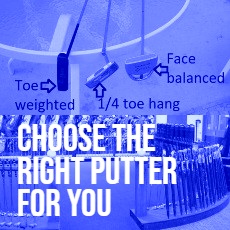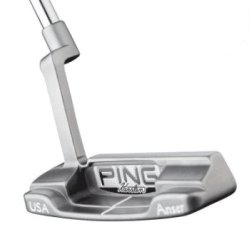Golf putter types and how to choose the best for you
"Which of the golf putter types should I choose?". It's a confusing question, but an important one if you're going to make the right choice when buying a new putter.
Here's a guide designed to simplify things.
I'm going to recommend an unconventional strategy that I see most elite players and pros use to find their ideal putter. It isn't a quick fix and relies on quite a bit of experimentation with different putter types and models.
This is what top pros do.
Of course they can do it so much quicker than we amateur players can because they have access to the tour trucks, but nevertheless, experimentation and trial and error is the best thing you can do to find what putter really suits you.
Oh - and I have this used to end up with a putter that I LOVE! Read more about my story here...
This method of putter choice will get you the best results and without enormous cost.
by William John
William JohnSite Owner
Step 1 - Decide what stroke type you're trying to achieve
There are three types of strokes that players try to produce:
a) A slight arc
This is where the putter moves slightly inside (towards your toe line) on both the back swing and follow through.
For this type of stroke you should be looking at a face-balanced putter. These are now the standard putters both in professional golf and among amateurs of all standards.
b) A strong arc
If your putter moves considerably off the ball-to-target line (towards your toe line), then the putter for you should be toe-balanced putter.
There's no right or wrong in how pronounced the arc of your putting stroke is. Tiger Woods, for example, has a strong arc to his stroke and obviously he was a great putter for decades.
The key is that you have the tool which matches your stroke shape and if you have an extremely arced putting stroke, you should have a putter which has weight in the toe to help the putter face to square through impact.
A putter like this is called either a toe-balanced, a toe-weighted or a toe-hang putter. The only difference is in the terminology!
c) A straight putting stroke
Having said there is no right or wrong option from the different putting strokes, a straight-back-and-through stroke is what wrecked my professional playing career in my 20s.
Now a bit older and wiser, I have realized that no top level professional uses this type of stroke successfully, either. They all have some sort of arc to their stroke.
(Read more about why I believe this is entirely the wrong way to try to putt here.)
I would therefore not advise anyone to try to use it. If you are hell-bent on doing so, though, you should definitely use a face balanced putter. The last thing you want is the face to be closing through the ball if you're trying to move it straight down the line to the hole.
Step 2 - Decide what suits your eye
Now you've got the right category of putter, you can be guided by aesthetics.
What style of putter head design do you most like looking down on?
Do you like a larger head (which would lead you to looking at a high moi mallet putter or do you prefer a more classic design?
This is simply a question of personal preference. There are great putters who use virtually every style of putter, although you should probably note that putters with very small sweet spots, such as bullseye style putters and heel shafted blade putters which were popular in the 1970s and 80s are hardly ever used now by top level players.
This is because the main advantage of modern designs is that the weight distribution means you will get better results with off-center putts.
This is because mallet and heel-toe weighted putters have increased stability and a larger sweet spot.
This should make them a first place to start for amateur golfers, unless you're an expert player.
Step 3 - Try some putters!
This is the fun part! Go out and try some putters.
Start at a store with a large number of demo putters.
Try to find a store which has a real outdoor putting green and test yourself over short, mid and long distances.
You will soon enough find which of the different types of putters suit you best and then look at options within that category.
Work through different types of face insert.
Manufacturers have worked hard on perfecting the material inserted into the putter's face. The most popular and effective of these give you a softer feel and this generally improves your judgment of distance.
Have a go with groove-faced putters too. These have all sorts of fancy technological claims associated with them. Don't spend too long listening to the marketing spiel, just have a go and decide whether you like them.
The other thing that trying putters should tell you is whether you align and putt better with an offset or onset face. Onset means the putter face is closer to the hole than the front side of the shaft. Onset putters are less common than offset putters which either have a double bend shaft or what's called a "plumber's neck" to take the putter back behind (i.e. further away from the target than) the shaft.
You should now have an idea of which of the different styles and which type of putter head you're interested in.
Step 4 - Put them into play
Top pros simply have putter manufacturers make up a dozen or so putters. Then they try them on the putting green and put their favorites into tournament play.
There's nothing that will tell you which putter is best for you other than a full golf game. Ideally under some pressure.
Until you've faced long and short, straight and heavily breaking putters, you won't know really which putter is your keeper.
The ideal way for you and me to try lots of different putters (unless you have a couple of grand to spend) is to purchase used putters on eBay.
I suggest you buy between 3 and 10 putters.
You'll spend about one-third of the retail price of each.
Try each of them and then re-sell the ones you don't like. You'll get virtually the same amount you paid for each of them and so the net cost to you will be very little, but this is the only way to duplicate the process top pros use.
Step 5 - Make minor adjustments
Once you're settled on your favorite(s), experiment with...
- Putter grip - Fatter grips work better for slight arc strokes and thin for strong arc strokes, but again it's a matter of what gets the best results and what feels best to you. The weight of the putter grip can also make a difference to how well you roll the golf ball. Click here for instructions on how to re-grip a putter.
- Putter length - Although you can check how long traditional length putters are for various golf putter types of player (also includes lengths for long putter and belly putters), you should experiment here too. I putt much better with a longer-than standard putter and maybe you will too. Click here for instructions for cutting down or extending a putter.
- Extra weight - Again, how heavy you want your putter is a matter of experimentation. Not many better putters add weight to their putters, but if you really feel the putter is too light, you can use adhesive lead tape to increase the weight. Be careful to put this equally across the back of the head of the putter or at the toe and heel of the club - failing to do this will alter the balance point of the face, and this can be disastrous.
- Loft - In general, it's best not to mess with the loft the manufacturer puts on the club, but if you can see the ball jumping noticeably when you strike it, you should have it checked by a club fitter.
- Lie angle - This can only be adjusted by a professional club fitter, and even they need to be careful not to alter the loft of the putter. They will be able to give you advice on what angle the putter shaft and the putter head make.
Summary
In order to find your perfect putter, you're going to have to work at it.
The best way I know of for amateurs who do not have access to free equipment from manufacturers is to follow the steps above and try a large number of different head shapes and weightings.
If, say, you've never used a groove-faced putter or a blade style putter, then you might be missing out on something. It is the most used club in your bag, so it's worth the time to find the best putter for you.
This is exactly the process I followed and I have now found my ideal putter and I don't even look at other models now.
So it's worked a treat for me. Click here to hear about my story.
What about a putter fitting?
My feeling with regard to putter fittings is that they're better than buying a putter straight off the rack, but not much better.
They certainly don't guarantee you'll end up with a putter that is a good fit for your playing style.
Why?
Because no matter how well the fitter knows your game, you'll always be doing the fitting inside on a flat artificial-grass green and you won't be able to experience all different types of putts on different green speeds without taking your new purchase to the course.
By that time you'll be $200-$500 lighter in the pocket.
The other thing a fitting can't give you is a feeling of having compared and decided on the best option for you.
You won't have been able to compare putters over the course of several weeks or months, which you can do if you follow my suggested ebay method above.
The same $200-$500 could allow you to test dozens of putters and keep the one you like best on real greens and under real conditions.
The main GOLF putter types
Here's a list of the main golf putter types arranged by design, balance and material. You can click through for our independent reviews of different models in each category and advice on where to buy them at the best price.
Click here to jump to each of the golf putter types we cover: anser style putters, blade putters, center shafted putters, futuristic putters, mallet putters, offset putters, onset putters, face balanced putters, toe weighted putters, insert putters, milled putters & cast putters.
Certain putters will support the type of stroke you're looking to use and others will hinder it, so choose wisely!
BEST Anser Style Putters
Designed by Karsten Solheim as one of the follow ups to his original Ping 1A putter, the
Anser is a simple but highly effective putter which was revolutionary in its design. It was the first putter to have a cavity hollowed out in its back. This has the effect of distributing much of the weight of the putter head to the heel and toe ends, which makes the sweetspot larger. Because of this you get far less twisting of the face on an off center strike and this makes the anser one of the most forgiving golf putter types. Any putter that has this overall square shape with heel and toe weighting is thought of as an Anser style. Click here for more info on Anser style putters.
 |
on an Ping Anser putter... |
Blade Putters
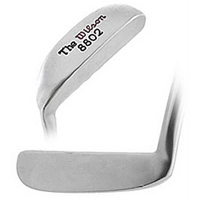 Blade putters are the traditionalists weapons of choice. Jack Nicklaus won almost all his majors with this style of putter. They are heavily toe weighted putters, so will only really suit an open-square-closed stroke.
Blade putters are the traditionalists weapons of choice. Jack Nicklaus won almost all his majors with this style of putter. They are heavily toe weighted putters, so will only really suit an open-square-closed stroke.Click on the links below to find out which is the best blade putter using www.Best-Putter.com's independent, hands-on reviews, you'll also find where to buy them at the best prices! Click here for Best-Putter.com's independent reviews of blade putters.
 |
on blade putters... |
Center-Shafted Putters
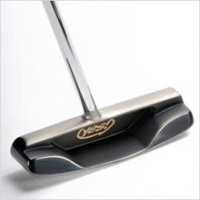 A center shafted putter is exactly what its name suggests - a putter where the shaft inserts into (more or less) the center of the head.
A center shafted putter is exactly what its name suggests - a putter where the shaft inserts into (more or less) the center of the head.
They are usually face balanced, so they will best suit a straight-back-straight-through stroke. If your putting stroke is more of an in-square-in stroke, then you may well be better off with an anser style putter or a blade putter. For our independent review of numerous center shafted putters, click here.
 |
on center shafted putters... |
Futuristic HIGH MOI Putters
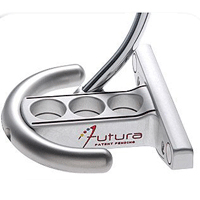 All conventional ideas about how a putter go out the window when companies design a high MOI putter. They are often enormous putters from face to back and often have shaft attachments well behind the face of the putter.
All conventional ideas about how a putter go out the window when companies design a high MOI putter. They are often enormous putters from face to back and often have shaft attachments well behind the face of the putter.Futuristic putters are the most technologically advanced and forgiving of the golf putter types. You'll find most companies claiming a high "moment of inertia" (often abbreviated to MOI) on their futuristic putters, meaning that the putter resists twisting if you strike the ball off center. Whether you think the weird looks are worth it is up to you! Click here for loads of reviews of futuristic putters. Click here for loads of reviews of futuristic putters.
 |
on futuristic putters... |
BEST Mallet Putters
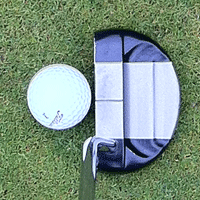 Mallet putters are so called because they look a bit like a croquet mallet - a solid lump on the end of the shaft. If you cut most modern mallet putter heads open you'll find that they're hollow with weights in the heel and toe of the head. This gives them a larger sweet spot and less likely to twist as a result of an off-center hit.
Mallet putters are so called because they look a bit like a croquet mallet - a solid lump on the end of the shaft. If you cut most modern mallet putter heads open you'll find that they're hollow with weights in the heel and toe of the head. This gives them a larger sweet spot and less likely to twist as a result of an off-center hit. Mallet putters are almost without exception face balanced, so will best suit so will best suit a slight arc or square-to-square stroke. Click here for Best-Putter.com's reviews of mallet putters.
 |
on mallet putters... |
Offset Putters
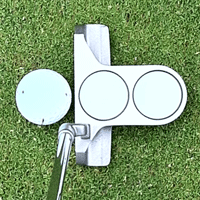 An offset putter is one where the putter face is set further from the hole at address than the shaft. This achieved by either having a kink
in the hosel (often called a plumber's neck" hosel) or a gentle curve in the shaft (called a flow neck). The vast majority of putters are offset. The reason is that it feels natural and almost automatic to have your hands ahead of a putter whose face is offset. When you lead the putter through the stroke with your hands you will almost certainly putt better because a putter which is being led through the stroke twists less on off-center hits -
Click here for reviews of offset putters from many different manufacturers.
An offset putter is one where the putter face is set further from the hole at address than the shaft. This achieved by either having a kink
in the hosel (often called a plumber's neck" hosel) or a gentle curve in the shaft (called a flow neck). The vast majority of putters are offset. The reason is that it feels natural and almost automatic to have your hands ahead of a putter whose face is offset. When you lead the putter through the stroke with your hands you will almost certainly putt better because a putter which is being led through the stroke twists less on off-center hits -
Click here for reviews of offset putters from many different manufacturers.
 |
on offset putters... |
Onset Putters
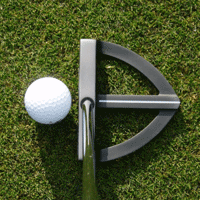 Onset putters are the exact opposite of offset putters. As you can just see in
this picture the face of an onset putter is closer to the hole than the point
where the shaft inserts into the putter head. The advantage of this type of
putter is that you can see the whole of the putter blade when you address the
ball and this can really help with your alignment.
Onset putters are the exact opposite of offset putters. As you can just see in
this picture the face of an onset putter is closer to the hole than the point
where the shaft inserts into the putter head. The advantage of this type of
putter is that you can see the whole of the putter blade when you address the
ball and this can really help with your alignment. Onset putters are quite hard to get hold of, however. You'll find a list of several options if you click here.
 |
on onset putters... |
Face Balanced Putters
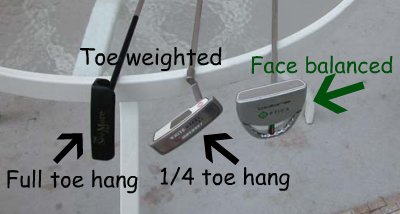 When a putter is face balanced, it means that the putter head is equally weighted between the toe and the heel relative to the point where the shaft enters the head. To test whether your putter is face balanced, lay the shaft of your putter across your palm. If the face lies absolutely horizontal, pointing up at the sky, then it's a
face balanced putter.
When a putter is face balanced, it means that the putter head is equally weighted between the toe and the heel relative to the point where the shaft enters the head. To test whether your putter is face balanced, lay the shaft of your putter across your palm. If the face lies absolutely horizontal, pointing up at the sky, then it's a
face balanced putter.The point of face balancing is to restrict the amount face of the club opens and closes as you swing back and through. Therefore you definitely want a face balanced putter if you are trying to swing the putter on a straight back, straight through line as putting teacher Dave Pelz suggests is best, but other teachers dispute. Click here for reviews of face balanced putters from many different manufacturers.
 |
on face balanced putters... |
Toe Weighted Putters
The weighting of a toe-weighted putter encourages the putter face to close through the ball. This is ideal if your stroke is an open-square-closed stroke (also known as a "barn door" stroke). The style of stroke and a toe weighted putter go hand in hand and reinforce each other. However, if you're trying to putt with a straight back straight through stroke, a toe weighted putter with extreme toe hang is the last thing you want. Click here for our reviews of toe-weighted putters.
 |
on toe weighted putters... |
Golf Putter Types - Head / Face Material
Insert Putters
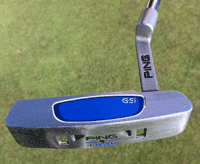 Insert putters are the only one of the golf putter types which have a different materials (the "insert") inlayed into the face. You actually strike the ball with this insert material and not the material used to make the main part of the putter head itself.
Insert putters are the only one of the golf putter types which have a different materials (the "insert") inlayed into the face. You actually strike the ball with this insert material and not the material used to make the main part of the putter head itself. Insert materials can be either hard or soft and you see manufacturers making all sorts of claims about the effect their inserts have on the way the putter feels, although the most common claim is that it softens the feeling of the ball against the putter head. Odyssey golf's White Hot and Ice White inserts are the market leading inserts. Click here for reviews of insert putters.
 |
on insert putters... |
Milled Putters
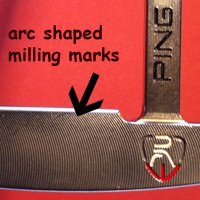 Milled putters are created from a single block of metal which is cut and shaved using a milling machine until it's the exact shape desired. You can tell milled putters from the arc shaped marks on the putter face made by the milling machine. Milling is the only way to make putters which have complex shapes featuring cavities and scoops out of 303 stainless steel which is generally accepted as giving the best feel of any putter head material. Since milling is more labor intensive than casting a putter head (see below), milled putters are generally the most expensive of all metal-faced putters.
Click here for reviews of milled putters from many different manufacturers.
Milled putters are created from a single block of metal which is cut and shaved using a milling machine until it's the exact shape desired. You can tell milled putters from the arc shaped marks on the putter face made by the milling machine. Milling is the only way to make putters which have complex shapes featuring cavities and scoops out of 303 stainless steel which is generally accepted as giving the best feel of any putter head material. Since milling is more labor intensive than casting a putter head (see below), milled putters are generally the most expensive of all metal-faced putters.
Click here for reviews of milled putters from many different manufacturers.
 |
on milled putters... |
Cast Putters
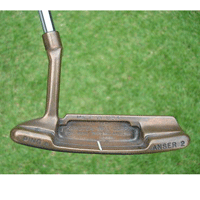 If you're looking at a complex shaped head (i.e. one that includes cavities etc) and it doesn't have milling marks (see pic above) on the face of the putter, then you're most likely looking at a cast putter made out of manganese bronze (a dull gold color), beryllium copper (a darker red or brown clay color) or carbon steel (a silver color). Seve Ballesteros and many of the greatest putters in history have been cast (the early Ping Anser and Ping Zing to name just two), so just because top pros feel they get slightly more feel out of a milled putter, doesn't mean you and I can't putt well with a cast putter.
If you're looking at a complex shaped head (i.e. one that includes cavities etc) and it doesn't have milling marks (see pic above) on the face of the putter, then you're most likely looking at a cast putter made out of manganese bronze (a dull gold color), beryllium copper (a darker red or brown clay color) or carbon steel (a silver color). Seve Ballesteros and many of the greatest putters in history have been cast (the early Ping Anser and Ping Zing to name just two), so just because top pros feel they get slightly more feel out of a milled putter, doesn't mean you and I can't putt well with a cast putter. The other major advantage at the moment is that all of these great putters are now cheap on the second hand market. Because manganese bronze in particular is extremely durable, you should find them in good condition too. If you're strapped for cash, this is a great golf putter type to go for!
 |
on cast putters... |
There are many different golf putter types to choose between. If you're still not sure which of the golf putter types to go for, read our article on choosing the right putter.
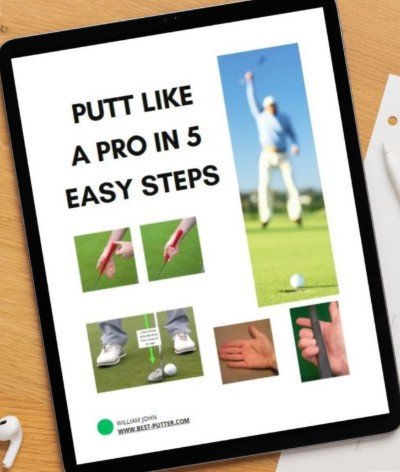 |
Return to the Best-Putter.com homepage

